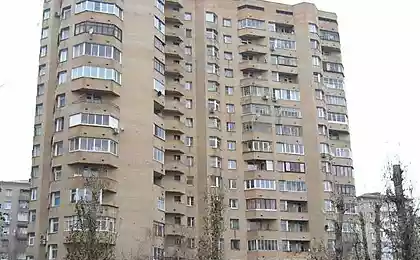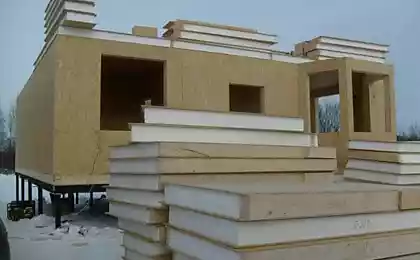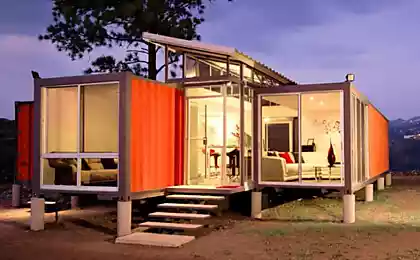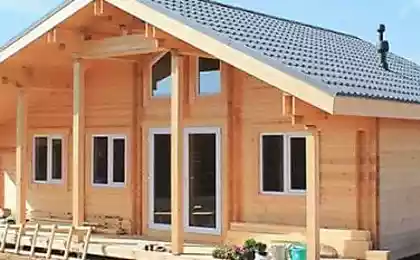389
The warmth of your home
Underfloor heating, the so-called “warm floor”, is becoming increasingly popular. Warm flooring is widely described online, including the comfortable, economic and medical benefits of water-heated flooring over other types of heating. We will not multiply the “warm words about floor heating”.
Note: someone who once, even temporarily, lived in rooms with underfloor heating, and in his own house wants to make floor heating.
Installation of warm floors is usually more expensive than installation of other heating methods. But floor heating allows you to reduce energy costs and operating costs for heating a building by 5-15 percent during operation. In addition to the comfort factor for residential and office premises, the economic factor - cheaper heating underfloor - is sometimes important for industry.
To reduce the construction period, it is possible to install a warm floor simultaneously with the construction of the “box”, or in winter.
Heated floor is ideal in rooms with hard floor coverings that have good thermal conductivity. The tile transmits heat well. Concrete, marble, etc. floor coverings are also ideal for underfloor heating.
In some cases, it is impossible to install underfloor heating. Or heating only underfloor, without auxiliary heating for example radiators, will not be able to provide comfort. As an example - in rooms where high air temperature is necessary and the floor surface temperature is limited - in pool rooms ..., or when using some types of floor coverings:
Carpet reduces the passage of heat from the floor to the room. A thick carpet will not let in enough heat. In order for the room to be heated, only a thin carpet can be put on floor heating. It is necessary to increase the temperature of the surface of the warm floor. It is wrong to exceed the temperature of the warm floor under the carpet more than 40 degrees - people, especially children, can get burned due to negligence, the carpet material and dust particles begin to decompose.
Therefore, under the carpet or furniture, it is desirable to arrange a warm water floor. The temperature of the water warm floor can be controlled in contrast to the electric warm floor. The electric warm floor will overheat under the carpet or furniture, spoil the coating and burn out;
Cork coating on floor heating, like carpet, reduces the passage of heat from the warm floor into the room. Cork is a beautiful thermal insulator. Put cork coating on a warm floor inefficiently;
Laminate floor heating, as well as carpet and cork coating, reduces the passage of heat from the floor. But the thermal conductivity of laminate is better than carpet and cork, so some types of laminate on a warm floor are allowed to be laid. The laminate must have an appropriate sign from the manufacturer allowing underfloor heating;
flooring, like laminate, reduces the passage of heat. Some types of parquet (from insufficiently hard wood or undried) when heated by the floor can dry and crack, parquet can begin to creak or fall out. Therefore, like laminate flooring, parquet must have the appropriate sign from the manufacturer, allowing underfloor heating. Such parquet must be laid strictly according to the technology determined by the parquet manufacturer. Otherwise, the manufacturer refuses responsibility for the parquet;
- parquet board and wooden floor, laid on floor heating, behaves similarly to parquet. Accordingly, manufacturers of parquet board and wood must guarantee the preservation of the performance of the material when laid on a warm floor. Local manufacturers, which usually have a non-standardized production, can not guarantee the preservation of parquet board and wooden floor under floor heating.
To eliminate the limitations of floor heating, there is wall heating. Wall heating, or a warm wall, is structurally similar to floor heating, but tubes with heating liquid are mounted in the walls, not in the floor. The tubes are filled with hot liquid, and get warm, warming walls.
Wall heating uses the heat emitted by a warm wall. The advantage of wall heating is that radiant heat from a warm wall provides a uniform temperature distribution between the ceiling and the floor, creates a soft and comfortable heating. Unlike traditional systems, a radiant thermal balance is achieved between a person and the surrounding surfaces of the room: the heat emitted by a person returns to a person from the environment.
When heating with a wall, a feeling of thermal comfort in a person occurs at air temperatures lower by 1-2 degrees than with ordinary heating. This allows you to reduce by another 3-6% the cost of heating with a warm wall compared to a warm floor.
The surface temperature of the wall up to 30 degrees provides small convective flows, minimal air mobility in the room. There is no hot air rising up and carrying fine dust. This spares the lungs, which is especially important for people suffering from allergies.
Warm wall allows you to quickly adjust the temperature in the room due to the relatively short heating time of the wall surface - the mass of plaster on the wall or plaster fiber board is much less than the mass of concrete in the warm floor.
Wall heating offers a combination of coziness and architectural freedom. The advantages of wall heating in combination with floor heating are especially clearly manifested - the area of heated surfaces increases, respectively, the temperature of heated surfaces and the temperature of the coolant can be reduced. This makes it possible to effectively use low-temperature heating systems - a heat pump, a solar collector and a condensation boiler.
Advantages of wall and floor heating compared to other heating systems:
Optimally healthy temperature profile, lack of dust circulation;
- the most comfortable for a person soft radiant heat from all sides of the room;
Reducing heating costs, saving energy;
- a short phase of warming the surface of a warm wall allows you to adjust the temperature in the room faster than using only a warm floor;
- the most efficient heating for low-temperature systems - heat pump, solar collector and condensation boiler. These devices will work with the highest efficiency in conjunction with heating with a warm floor and a warm wall;
Absolutely aesthetic due to the lack of heating devices.
Heating surfaces - floor and wall - is advisable especially in rooms with a constant stay of people, allergies, areas of increased comfort, recreation areas, wet rooms - bathrooms, saunas, pools.
In winter, it is comfortable to heat the room with a warm floor and / or wall. And in summer, on hot days, in the tubes laid in the walls, you can let a cold liquid cooling the walls, and taking heat from the room. Then the system will begin air conditioning (cooling) the room wall and / or floor.
By analogy with a warm floor, floor cooling is called floor cooling or cold flooring. Wall cooling is called wall cooling or cold wall.
The wall and floor heating and cooling system, in addition to the above mentioned advantages of floor and wall heating, provides:
heating and cooling using a single system with low investment and operating costs;
high comfort and a healthy microclimate, the absence of cold air currents and drafts;
No noise from the cooling system;
Cooling with a wall is advisable especially in rooms of increased comfort, bedrooms, recreation areas, areas of stay of people with impaired health, suffering from diseases of pressure and heart.
Floor cooling is advisable, first of all, in office and production premises.
P.S. And remember, just changing our consumption – together we change the world!
Join us on Facebook, VKontakte, Odnoklassniki
Source: economic-energy.com.ua/article/article7.html
Note: someone who once, even temporarily, lived in rooms with underfloor heating, and in his own house wants to make floor heating.
Installation of warm floors is usually more expensive than installation of other heating methods. But floor heating allows you to reduce energy costs and operating costs for heating a building by 5-15 percent during operation. In addition to the comfort factor for residential and office premises, the economic factor - cheaper heating underfloor - is sometimes important for industry.
To reduce the construction period, it is possible to install a warm floor simultaneously with the construction of the “box”, or in winter.
Heated floor is ideal in rooms with hard floor coverings that have good thermal conductivity. The tile transmits heat well. Concrete, marble, etc. floor coverings are also ideal for underfloor heating.
In some cases, it is impossible to install underfloor heating. Or heating only underfloor, without auxiliary heating for example radiators, will not be able to provide comfort. As an example - in rooms where high air temperature is necessary and the floor surface temperature is limited - in pool rooms ..., or when using some types of floor coverings:
Carpet reduces the passage of heat from the floor to the room. A thick carpet will not let in enough heat. In order for the room to be heated, only a thin carpet can be put on floor heating. It is necessary to increase the temperature of the surface of the warm floor. It is wrong to exceed the temperature of the warm floor under the carpet more than 40 degrees - people, especially children, can get burned due to negligence, the carpet material and dust particles begin to decompose.
Therefore, under the carpet or furniture, it is desirable to arrange a warm water floor. The temperature of the water warm floor can be controlled in contrast to the electric warm floor. The electric warm floor will overheat under the carpet or furniture, spoil the coating and burn out;
Cork coating on floor heating, like carpet, reduces the passage of heat from the warm floor into the room. Cork is a beautiful thermal insulator. Put cork coating on a warm floor inefficiently;
Laminate floor heating, as well as carpet and cork coating, reduces the passage of heat from the floor. But the thermal conductivity of laminate is better than carpet and cork, so some types of laminate on a warm floor are allowed to be laid. The laminate must have an appropriate sign from the manufacturer allowing underfloor heating;
flooring, like laminate, reduces the passage of heat. Some types of parquet (from insufficiently hard wood or undried) when heated by the floor can dry and crack, parquet can begin to creak or fall out. Therefore, like laminate flooring, parquet must have the appropriate sign from the manufacturer, allowing underfloor heating. Such parquet must be laid strictly according to the technology determined by the parquet manufacturer. Otherwise, the manufacturer refuses responsibility for the parquet;
- parquet board and wooden floor, laid on floor heating, behaves similarly to parquet. Accordingly, manufacturers of parquet board and wood must guarantee the preservation of the performance of the material when laid on a warm floor. Local manufacturers, which usually have a non-standardized production, can not guarantee the preservation of parquet board and wooden floor under floor heating.
To eliminate the limitations of floor heating, there is wall heating. Wall heating, or a warm wall, is structurally similar to floor heating, but tubes with heating liquid are mounted in the walls, not in the floor. The tubes are filled with hot liquid, and get warm, warming walls.
Wall heating uses the heat emitted by a warm wall. The advantage of wall heating is that radiant heat from a warm wall provides a uniform temperature distribution between the ceiling and the floor, creates a soft and comfortable heating. Unlike traditional systems, a radiant thermal balance is achieved between a person and the surrounding surfaces of the room: the heat emitted by a person returns to a person from the environment.
When heating with a wall, a feeling of thermal comfort in a person occurs at air temperatures lower by 1-2 degrees than with ordinary heating. This allows you to reduce by another 3-6% the cost of heating with a warm wall compared to a warm floor.
The surface temperature of the wall up to 30 degrees provides small convective flows, minimal air mobility in the room. There is no hot air rising up and carrying fine dust. This spares the lungs, which is especially important for people suffering from allergies.
Warm wall allows you to quickly adjust the temperature in the room due to the relatively short heating time of the wall surface - the mass of plaster on the wall or plaster fiber board is much less than the mass of concrete in the warm floor.
Wall heating offers a combination of coziness and architectural freedom. The advantages of wall heating in combination with floor heating are especially clearly manifested - the area of heated surfaces increases, respectively, the temperature of heated surfaces and the temperature of the coolant can be reduced. This makes it possible to effectively use low-temperature heating systems - a heat pump, a solar collector and a condensation boiler.
Advantages of wall and floor heating compared to other heating systems:
Optimally healthy temperature profile, lack of dust circulation;
- the most comfortable for a person soft radiant heat from all sides of the room;
Reducing heating costs, saving energy;
- a short phase of warming the surface of a warm wall allows you to adjust the temperature in the room faster than using only a warm floor;
- the most efficient heating for low-temperature systems - heat pump, solar collector and condensation boiler. These devices will work with the highest efficiency in conjunction with heating with a warm floor and a warm wall;
Absolutely aesthetic due to the lack of heating devices.
Heating surfaces - floor and wall - is advisable especially in rooms with a constant stay of people, allergies, areas of increased comfort, recreation areas, wet rooms - bathrooms, saunas, pools.
In winter, it is comfortable to heat the room with a warm floor and / or wall. And in summer, on hot days, in the tubes laid in the walls, you can let a cold liquid cooling the walls, and taking heat from the room. Then the system will begin air conditioning (cooling) the room wall and / or floor.
By analogy with a warm floor, floor cooling is called floor cooling or cold flooring. Wall cooling is called wall cooling or cold wall.
The wall and floor heating and cooling system, in addition to the above mentioned advantages of floor and wall heating, provides:
heating and cooling using a single system with low investment and operating costs;
high comfort and a healthy microclimate, the absence of cold air currents and drafts;
No noise from the cooling system;
Cooling with a wall is advisable especially in rooms of increased comfort, bedrooms, recreation areas, areas of stay of people with impaired health, suffering from diseases of pressure and heart.
Floor cooling is advisable, first of all, in office and production premises.
P.S. And remember, just changing our consumption – together we change the world!
Join us on Facebook, VKontakte, Odnoklassniki
Source: economic-energy.com.ua/article/article7.html
Our gut – stimulating system of the entire body!
Smoothies strawberry and Basil: low-calorie and original smoothies
























